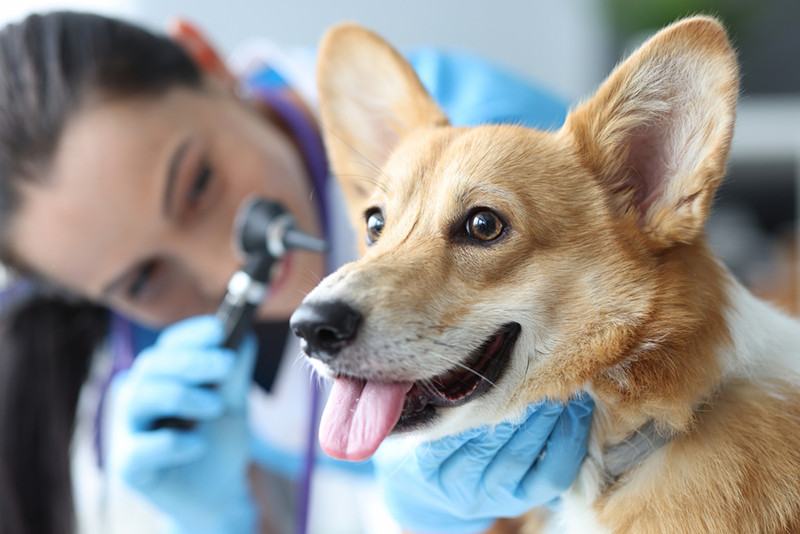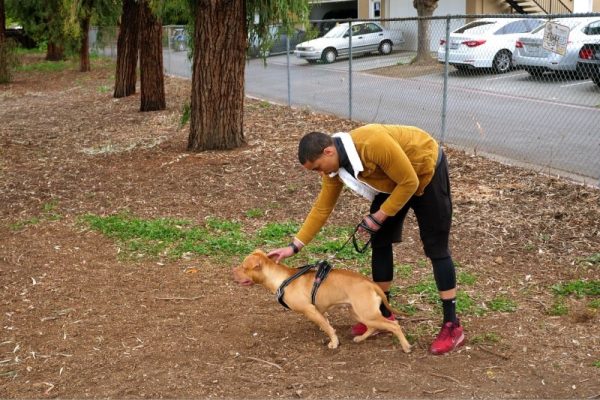In this article
As pet owners, we want our dogs to be happy and healthy, but sometimes they may experience health issues, including hearing loss. While hearing loss is a common issue in humans, it can also occur in dogs. But how do we know if they do have hearing loss? Do dogs have hearing tests? Well, yes! Dogs have their own hearing tests and the most common one used is called the Brainstem Auditory Evoked Response or BAER.
In this article, we will explore the BAER test for dogs, the causes, and symptoms of hearing loss in dogs, the importance of diagnosing it early, and the available steps that we can do for our furry friends with hearing loss.

The Brainstem Auditory Evoked Response Test for Dogs
The Brainstem Auditory Evoked Response (BAER) test is a hearing test used to diagnose hearing loss in dogs. It is a non-invasive procedure that measures the electrical activity of the auditory nerve and brainstem in response to sound stimuli.
During the BAER test, the dog wears earphones that deliver clicks or tones of varying frequencies and intensities. Electrodes placed on the scalp measure the electrical activity of the auditory nerve and brainstem, and the results are recorded and analyzed.
The BAER test can detect hearing loss in one or both ears, determine the degree of hearing loss, and identify the specific part of the auditory system that is affected. When properly diagnosed, this information can help the veterinarian provide appropriate treatment options and make recommendations for living with a hearing-impaired dog.
Note that not all cases of hearing loss can be detected through BAER and that there may be contraindications in performing the BAER such as if your dog has an active ear infection. Be sure to consult and follow your veterinarian’s recommendations regarding your dog’s hearing.


What Is Hearing Loss in Dogs?
Hearing loss in dogs occurs when their ability to hear sounds is reduced or completely lost. There are different types of hearing loss, including conductive, sensorineural, and mixed hearing loss depending on where the damage is located along the auditory apparatus.
There are various ways a dog can eventually develop hearing loss. In some cases, genetics plays a huge role while others eventually acquire them through old age or injuries.
The Importance of Diagnosing Hearing Loss in Dogs
Diagnosing hearing loss early is essential to prevent the development of other health issues that may arise from untreated hearing loss, such as anxiety or behavioral issues. Additionally, diagnosing hearing loss can provide valuable information for living with a hearing-impaired dog and provide access to appropriate treatment options.

Breeds Susceptible to Hearing Loss
All dogs can potentially have deafness at birth, but there are a few breeds that are more susceptible to it than others. Dalmatians are known for their high predisposition to hearing loss, with around 30% of the breed experiencing it. Australian Shepherds and Bull Terriers also have a high risk of hearing loss.

Hearing Loss Causes
Congenital and Genetic
Congenital causes of hearing loss in dogs are present at birth and can be due to an underdeveloped ear canal or abnormality in the inner ear. Genetic causes of hearing loss in dogs may be inherited from their parents, leading to abnormalities in the cochlea or auditory nerve.
Dogs with piebald color genes or merle color genes are also at risk of congenital hearing loss.
Acquired Causes
Acquired causes of hearing loss in dogs may occur due to trauma or pathologies to a healthy dog ear, or hearing loss that develops later in life.
- Old age
- Ear infections
- Exposure to loud sounds
- Tumors
- Head injuries
- Degenerative nerve changes
- Perforation in the ear drum
- Ototoxic medications

Signs of Hearing Loss to Look Out for in Your Dog
As a pet owner, it’s essential to be aware of the signs of hearing loss in dogs to seek prompt medical attention and diagnosis.
- Unresponsive to environmental sounds
- Unresponsive to name-calling
- Unresponsive to loud noises and noise-making toys
- Difficulty localizing sounds
- Lack of activity and energy
- Excessive whining and barking
- Difficulty to wake up


How Can I Screen My Dog for Hearing Loss?
There are a few creative ways to screen your dog for hearing loss at home. One is to observe their behavior when you make sounds or call their name from different distances.
Additionally, you can use objects that make different sounds, like rattling a set of keys, banging the door, or clanging metal pans to see if your dog responds. Note that when making a noise, be sure you are out of the line of sight of your dog to prevent any visual cues when responding!
Living with a Dog with Hearing Loss
Living with a dog with hearing loss may require some adjustments, such as using hand signals instead of verbal commands or ensuring that your dog is always within sight.
Despite their impaired sense, many dogs with hearing loss can still live happy and fulfilling lives with the right support and training. As dog parents, it’s essential to be patient with your dog and provide them with a safe and comfortable environment.
Additionally, it’s crucial to actively take the necessary steps to protect your dog from potential dangers, such as keeping them on a leash when outside or installing safety barriers in your home to prevent falls or accidents.
Regular checkups with a veterinarian can also help to monitor your dog’s hearing loss and overall health.
Are There Hearing Aids Available for Dogs?
Like humans, there are hearing aids available for dogs. Hearing aids for dogs work similarly to those for humans, amplifying sounds to improve hearing. These devices can be customized to fit the shape and size of your dog’s ear and can improve their quality of life by allowing them to hear better.
It is important to note that hearing aids are not a cure for hearing loss but are merely a tool to help them with their decreased hearing. Hearing aids also have a candidacy criterion and may not be suitable for all dogs.
Your veterinarian can help determine if a hearing aid is an appropriate option for your dog and recommend the best type for their specific needs.

Conclusion
The Brainstem Auditory Evoked Response (BAER) test is a non-invasive hearing test that can diagnose hearing loss in dogs and provide valuable information for living with a hearing-impaired dog. Hearing loss is a common issue in dogs that can be caused by a variety of factors. It’s important to be aware of the signs of hearing loss in dogs and seek prompt medical attention if you suspect your dog is experiencing hearing loss.
Living with a dog with hearing loss may require some adjustments, but with the right support and love, dogs with hearing loss can still lead happy and fulfilling lives!
Featured Image Credit: Beatriz Vera, Shutterstock



















